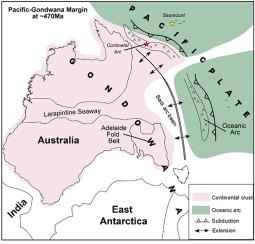Lithos ( IF 3.5 ) Pub Date : 2021-07-02 , DOI: 10.1016/j.lithos.2021.106343 Hans N. Dirks 1 , Ioan V. Sanislav 1 , Ahmed S.A.A. Abu Sharib 2

|
New geochronological findings, using zircon dating, supported with geochemical and structural data from the Running River Metamorphics (RRM), Thomson Orogen of the Tasmanides, have been used to reinvestigate the Paleo-Pacific margin of Australia during the Early Paleozoic. The RRM comprises a greenschist to amphibolite facies metamorphic succession of gneisses, amphibolite, and quartzite that is intruded by the Ordovician Falls Creek Tonalite. Protoliths of the gneisses and tonalite are interpreted to be emplaced at ~472 and ~457 Ma, respectively, whereas a maximum depositional age of the protolith of the quartzite is constrained to ~471 Ma. Geochemically, the gneisses and tonalite have calc-alkaline signature, and represent S-and I-type granitoids, respectively, that formed in a continental arc setting. The amphibolites have oceanic island basalt-like affinity, and together with the coeval quartzite are interpreted to represent a relict seamount. Five deformation events were identified in the RRM. D1 and D2, and D3 are interpreted to be subduction- and collision-related, respectively. D4 most probably accompanied the movement along the NE segment of the Clarke River Fault, and resulted in rotation of the earlier fabrics into the dominant NE orientation. The timing of tectonism can be constrained between the intrusion of the S-type gneisses at 472 Ma and the intrusion of the undeformed migmatites at ~437 Ma. The common stratigraphy, tectono-metamorphic history, geochemistry, and overlapping dates of the different provinces of the Thomson orogen suggest that following the Delamerian orogeny, the paleo-Pacific margin of Australia has been a convergent plate boundary during Middle Ordovician to Middle Silurian. Our results imply that convergence has been underway along the eastern margin of Australia during the Cambro-Silurian times and hence pushing the boundary of the Delamerian orogeny to the end of Ordovician in the northern part of the Thomson Orogen.
中文翻译:

早古生代沿澳大利亚古太平洋边缘的连续辐合:来自昆士兰东北部奔流河变质区的见解
新的地质年代学发现,使用锆石测年,并得到塔斯马尼德的汤姆森造山带的运行河变质岩 (RRM) 的地球化学和结构数据的支持,已被用于重新调查早古生代期间澳大利亚的古太平洋边缘。RRM 包括绿片岩到角闪岩相变质系列片麻岩、角闪岩和石英岩,被奥陶纪瀑布溪 Tonalite 侵入。片麻岩和透长岩的原岩被解释为分别位于~472 和~457 Ma,而石英岩原岩的最大沉积年龄限制在~471 Ma。地球化学上,片麻岩和钠长岩具有钙碱性特征,分别代表在大陆弧环境中形成的 S 型和 I 型花岗岩。角闪岩具有海洋岛屿玄武岩的亲和力,与同时代的石英岩一起被解释为代表一个残存的海山。在 RRM 中确定了五个变形事件。D1和 D 2和 D 3分别被解释为与俯冲和碰撞相关。d 4最有可能伴随着克拉克河断层 NE 段的运动,并导致早期构造旋转到主导的 NE 方向。构造作用的时间可以限制在 472 Ma 的 S 型片麻岩的侵入和~437 Ma 的未变形混合岩的侵入之间。汤姆森造山带不同省区的共同地层、构造-变质历史、地球化学和重叠年代表明,继德拉梅里造山运动之后,澳大利亚古太平洋边缘在中奥陶世至中志留世期间一直是一个会聚的板块边界。



























 京公网安备 11010802027423号
京公网安备 11010802027423号